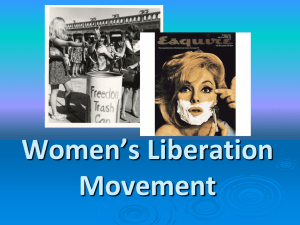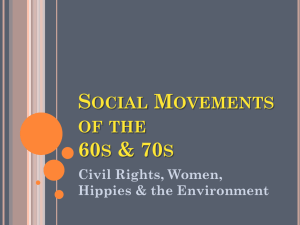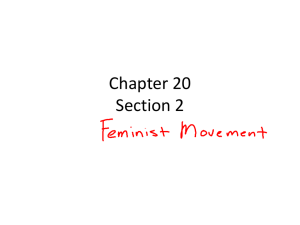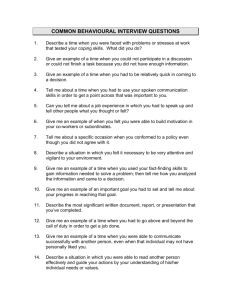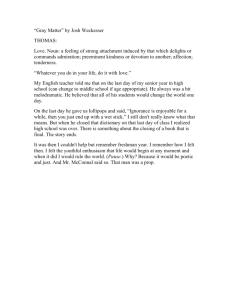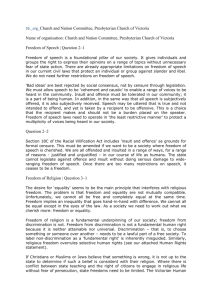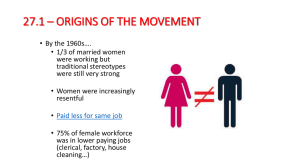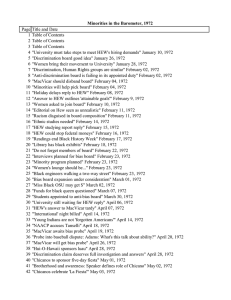Women's Rights - Walsingham Academy
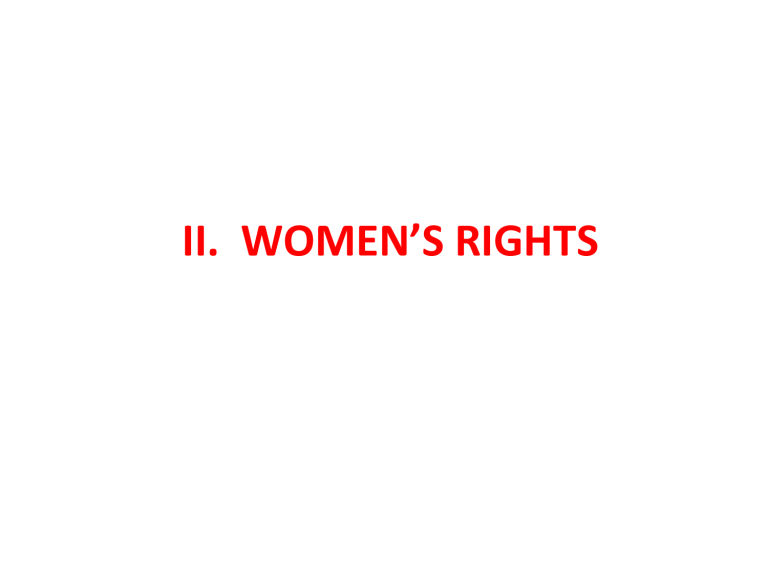
II. WOMEN’S RIGHTS
BACKGROUND
Early Women’s Rights Movement
• Began in late 1800s
– Fight for right to
• Vote
• Obtain equality in education and jobs
• Term “feminism” first used in 1895 to describe economic, political, and social equality of men and women
• Feminists are those who believe in this and their actions to bring it about
• Stereotype of women married, at home, and raising children prevailed through the 1950s
– Was not always an accurate reflection
• Many women had worked out of necessity during WWII and continued to work after the war
• By 1965 38% of women worked outside the home
Role of Education
• The number of women receiving higher education degrees nearly doubled between 1950 and 1970
– Wanted to put their education to work
• Faced discrimination in job hunting
– Employers concerned women would quit job to have children
– Employers felt a woman’s only role should be at home
• Women who did find work were often underemployed
– Working a job that requires skills below ability
– Women earned approximately 57 cents for every dollar earned by a man in an identical job by 1973
Impact of the Civil Rights Movement
• Provided women inspiration and served as a model for how to achieve equality
– Women working during the Civil Rights Movement gained skills that they could transfer to the Women’s
Movement
• Civil Rights Act of 1964
– Included terminology to prohibit discrimination based on gender
• Initially included to prevent the bill from being passed
WOMEN ORGANIZE
The Feminine Mystique
• During the Civil Rights Movement women began to meet to discuss how they could play a larger role in the movement
• Betty Friedan’s 1963 book called The Feminine
Mystique shocked the nation and mobilized many suburban women into action
– Written to subordinate middle class women who society deemed had everything but felt unhappy
– Encouraged women to ask “is this all?” and to recognize that they could have more if they wanted it
NOW
• 1966 group of 28 business women, including
Friedan, established the group the National
Organization for Women (NOW)
• Goal was to “take action to bring women into full participation in mainstream American society”
• Demands of NOW
– Fair pay
– Equal job opportunities
– Attacked marketing campaigns they considered portrayed a false image of women
– Balanced marriage where parenting and household chores were shared
• After four years the organization had over
15,000 members
Response to NOW
• Some women felt it was too extreme
• Others believed it only favored white, middle class women
• Still others considered the organization too soft in its actions
Impact of Feminism
• Opened availability of knowledge to women
– Our Bodies, Ourselves
• Handbook for women’s health issues sold 200,000 in first year of publication
• 12 th edition published in 2005 and has sold over 3 million copies
• Today has expanded to work with women in third world countries to bring about health care change
– Ms. Magazine
• Founded by Gloria Steinem
• First issue in 1972 sold out in eight days
• Sharp contrast to traditional women’s magazines such as Good
Housekeeping and Ladies’ Home Journal
Political Changes
• 1972 Higher Education Act
– Included a prohibition against admissions discrimination based on gender
• Assisted women in gaining admission to military academies and increased the number of women entering jobs in the fields of business, law and medicine
• National Women’s Political Caucus
– Formed to expand women’s participation in politics
– Helped Shirley Chisholm
• The first African American women elected to Congress
• Ran for Democratic presidential nomination in 1972
– Paved the way for Geraldine Ferraro to be selected as
Democratic presidential candidate Walter Mondale’s running mate in 1984
Radical Feminists
• Promoted stronger goals for the Women’s Movement including
– End of what they viewed as male domination
– Rejection of
• Men
• Marriage
• Childbearing
Roe v. Wade
• Abortion was a divisive issue among NOW members
• 1973 Supreme Court ruled
– Abortion was legal based on the constitutional right to privacy
– Struck down state laws banning abortion in the first three months of pregnancy
• Allowed states to regulate abortion after three months
– Most controversial Supreme Court ruling to date
Equal Rights Amendment (ERA)
• First written by Alice Paul in 1923
• Would make discrimination based on gender illegal
• In 1972 it passed both the House and Senate but was only ratified by 35 (out of the 38 necessary) states
• 1982 deadline to ratify the ERA initially ended it
– However in 2009 Carolyn Maloney (Democratic
Representative from New York) reintroduced the amendment
Opposition to the Women’s Movement
• Phyllis Schlafly led the opposition movement to the passage of the ERA
– Felt it eliminate women’s right to
• Alimony
• Exemption from military service
• Women’s only colleges and universities
• Some women felt that
– The Women’s Movement undervalued their role as homemakers
– NOW assumed that all women were unhappy in traditional roles
